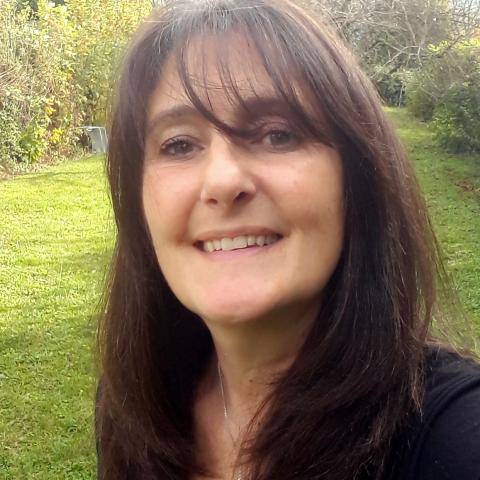CAROLINE JOLLY
Chargée de recherche (CNRS) (CNRS)
- Share
- Share on Facebook
- Share on X
- Share on LinkedIn
Permanente, Développement et Apprentissage

Contact details
Building : Bât. Michel Dubois
Office : E111
1251 avenue centrale
BP47
38040 Grenoble cedex
France
Tel. : 0476748139
Caroline.Jolly@univ-grenoble-alpes.fr
Research topics
Contrôle et apprentissage moteur de l'écriture, Trouble développemental de l'écriture (dysgraphie), Aide au diagnostic
Scientific disciplines
Neurosciences cognitives, Développement et Apprentissages de l'Enfant
Curriculum vitae
FONCTION ACTUELLE : CRCN CNRS depuis 2000 au Laboratoire de Psychologie et NeuroCognition, UMR 5105
CURSUS : Après des études de biologie cellulaire et moléculaire, j'ai soutenu ma thèse en octobre 1997 à l'Université Grenoble Alpes sur le thème "Gènes induits par le stress". De 1998 à 1999, j'ai ensuite réalisé un stage post-doctoral aux Etats-Unis dans le laboratoire du Pr Morimoto à l'Université de Northwestern (Evanston, IL), où j'ai travaillé sur l'a régulation de l'expression des gènes de choc thermique. J'ai été recrutée en tant que CR2 CNRS en janvier 2000, dans l'équipe DyOGen de l'INSERM U823 (Institut pour l'Avancée des Biosciences) à Grenoble. En octobre 2008, j'ai changé de domaine de recherche et de laboratoire d'affectation. J'ai intégré le LPNC.
ACTIVITES DE RECHERCHE: Depuis mon arrivée au LPNC, mes travaux de recherche sont centrés autour de (i) la compréhension des mécanismes cognitifs et sensori-moteurs impliqués dans l'apprentissage de l'écriture manuscrite chez l'enfant, et (ii) le développement d'outils d'aide au diagnostic des troubles de l'écriture (dysgraphie).
ENCADREMENTS DE THESE:
● Raphaël Lambert : « Apport de l’analyse conjointe des paramètres cinématiques de l’écriture, de l’activité cérébrale et oculométrique dans des modèles supervisés pour l’aide au diagnostic de la dysgraphie » - en co-encadrement avec Jérôme Boutet (CEA-LETI)
● Laureen Josseron : « Mémoire de l’ordre et de l’espace chez des enfants présentant un Trouble Développemental des Coordinations/Dyspraxie » - en co-encadrement avec Jérôme Clerc (LPNC)
PROJETS:
● NumEC : ANR franco-québécoise sur « L’apport des outils numériques pour étudier l’écriture et améliorer son apprentissage en France et au Québec »
Publications
● Lambert R, Boutet J, Labyt E, Jolly C (2023). Analysis of eye movements in children with developmental coordination disorder during a handwriting copy task. Lecture Notes in Computer Science (sous presse).
● Jolly C, Jover, M, Danna J (2023). Dysgraphia differs between children with developmental coordination disorder and/or dyslexia. Journal of Learning Disabilities (en révision).
● Lafitte R, Diaine F, Dai S, Carré O, Dupierrix E, Jolly C, Piscicelli C, Pérennou D (2023). Clinimetric properties of relevant criteria for assessing writing and drawing orientation after right hemisphere stroke. Journal of Neuroscience Methods 394, p109900.
● Vaivre-Douret L, Mazeau M, Jolly C, Huron C, Arnaud C, Gonzalez-Monge S, Assaiante C (2021). L’expertise collective de l’Inserm sur le trouble développemental de la coordination ou dyspraxie: état des principaux travaux et recommandations. Neuropsychiatrie de l’Enfance et de l’Adolescence 69(6), p311-330.
● Deschamps L, Devillaine L, Gaffet L, Lambert R, Aloui S, Boutet J, Brault V, Labyt E, Jolly C (2021). Development of a Pre−Diagnosis Tool Based on Machine Learning Algorithms on the BHK Test to Improve the Diagnosis of Dysgraphia. Advances in Artificial Intelligence and Machine Learning 1(2) : p8-27.
● Castéran L, Deschamps L, Boutet J, Sloui S, N’Guyen-Morel M-A, Labyt E, Jolly C (2021). Identification de deux sous-types de dysgraphia à partir de l’analyse de paramètres cinématiques de l’écriture d’enfants typiques et porteurs de dysgraphie. ApprochesNeuropsychologiques des Apprentissages de l’Enfant 172, p119-132.
● Gargot T, Asselborn T, Pellerin H, Zammouri I, Anzalone SM, Casteran L, Johal W, Dillenbourg P, Cohen D, Jolly C (2020). Acquisition of handwriting in children with and without dysgraphia: a computational approach. PLoS ONE 15 (9), e0237575.
● Albaret J-M, Arnaud C, Assaiante C, Gonzalez−Monge S, Huron C, Jolly C, Kaiser M-L, Liotard P, Mazeau M, Tallet J, Vaivre-Douret L, Woollven M (2019). Troubles développementaux de la coordination ou dyspraxie. EDP Sciences, Paris.
● Asselborn T, Gargot T, Kidzinski L, Johal W, Cohen D, Jolly C, Dillenbourg P (2018). Reply: Limitations in the creation of an automatic diagnosis tool for dysgraphia. Npj Digital Medicine 2: article 37.
● Jolly C (2017). Dyspraxies et troubles de l’écriture. Approche Neuropsychologique des Apprentissages de l’Enfant 151 : 1-7.
● Jolly C, Huron C, and Gentaz E (2014). A one-year survey of cursive letter handwriting in a French second-grade child with Developmental Coordination Disorder. L'Année Psychologique 114: 421−445.
● Jolly C and Gentaz E (2014). Analysis of cursive letters, syllables, and words handwriting in a French second-grade child with Developmental Coordination Disorder and comparison with typically developing children. Frontiers in Psychology 4: 1022 (doi: 10.3389/fpsyg.2013.01022). eCollection 2013.
● Jolly C, Palluel-Germain R, and Gentaz E (2013). Evaluation of a tactile training for handwriting acquisition in French kindergarten children: A pilot study. In H. Switzer and D. Foulke (Eds.), Kindergartens: Teaching methods, expectations and current challenges (pp. 161-176). Nova Science Publishers: Hauppauge (USA).
● Jolly C, Palluel-Germain R, and Gentaz E (2013). Apport des interfaces haptiques et tactiles dans les apprentissages multisensoriels de l’écriture. In J.M. Albaret, M.L Kaiser, and R. Soppelsa (Eds.), Troubles de l'écriture chez l'enfant: des modèles à l'intervention (pp. 115-133). Solal De Boeck, Marseille.
● Kaminski G, Berger C, Jolly C, and Mazens K (2013). Children’s consideration of relevant and non relevant facial features in kinship detection. L'Année Psychologique 113: 321−334.
● Jolly C, and Gentaz E (2013). Evaluation des effets d'entraînements avec tablette tactile destinés à favoriser l'écriture de lettres cursives chez des enfants de Cours Préparatoire. STICEF 20, ISSN : 1764-7223, mis en ligne le 12/07/2013, http://sticef.org.
● Jolly C, Huron C, Albaret J-M, and Gentaz E (2010). Analyse comparative des tracés de lettres cursives d’une enfant atteinte d’un trouble d’acquisition de la coordination et scolarisée en CP avec ceux d’enfants ordinaires de GSM et de CP. Psychologie Française 55: 145-170.
● Eymery A, Souchier C, Vourc’h C, and Jolly C (2010). Heat Shock Factor 1 binds to and transcribes satellite II and III sequences at several pericentromeric regions in heat-shocked cells. Exp. Cell Res. 316: 1845-1955.
● Fritah-Hnida S, Col E, Boyault C, Chiocca S, Khochbin S, Jolly C, and Vourc'h C (2009). Histones deacetylases as novel factors of heat shock response. In Cellular Oncology 31: 104-104. Nieuwe Hemweg 6B, 1013 BG Amsterdam, Netherlands: IOS PRESS.
● Fritah S, Col E, Boyault C, Govin J, Sadoul K, Chiocca S, Christians E, Khochbin S, Jolly C, and Vourc’h C (2009). Heat shock factor 1 controls genome-wide acetylation in heat-shocked cells. Mol. Biol. Cell 20: 4976-4984.
● Sandqvist A, Björk JK, Akerfelt M, Chitikova Z, Grichine A, Vourc'h C, Jolly C, Salminen TA, Nymalm Y and Sistonen L (2009). Heterotrimerization of HSF1 and HSF2 Provides a Transcriptional Switch in Response to Distinct Stimuli. Mol. Biol. Cell 20: 1340-1347.
● Jolly C and Lakhotia SC (2006). Human sat III and Drosophila hsrw transcripts: a common paradigm for regulation of nuclear RNA processing in stressed cells. Nucleic Acids Res. 34: 5508-5514.
● Metz A, Soret J, Vourc’h C, Tazi J, Jolly C (2004). A key role for stress-induced satellite III transcripts in the relocalization of splicing factors into nuclear stress granules. J Cell Sci 117: 4551-4558.
● Jolly C, Metz A, Govin J, Vigneron M, Turner BM, Khochbin S, Vourc’h C (2004). Stress-induced transcription of satellite III repeats. J Cell Biol 164: 25-33.
● Jolly C, Konecny L, Kutskova YA, Cotto JJ, Morimoto RI, Vourc'h C (2002). In vivo binding of HSF1 to human chromosome 9 heterochromatin during stress. J.Cell Biol 156: 775-81.
● Mathew A, Mathur SK, Jolly C, Morimoto RI (2001). Stress-specific activation and repression of heat shock factors 1 and 2. Mol. Cell. Biol. 21: 7163-7171.
● Mathew A, Shi Y, Jolly C, and Morimoto RI (2000). Analysis of the mammalian heat shock response: Inducible gene expression and heat shock factor activity. In Methods in Molecular Biology, 99: Stress Response: Methods and Protocols, p217-255. Humana Press Inc., Totowa, NJ.
● Jolly C, Morimoto RI (2000). Role of the heat shock response and molecular chaperones in oncogenesis and cell death. J. Natl. Cancer Inst. 92: 1564-1572.
● Jolly C, Denarier E, Mongelard F, Robert-Nicoud M, Vourc'h C, Bosc C, and Job D (1999). Assignment of the STOP gene (MAP6) to human chromosome bands 6p12-->p11 by fluorescence in situ hybridization. Cytogenet. Cell Genet.86: 25.
● Jolly C and Morimoto RI (1999). Stress and the cell nucleus: dynamics of gene expression and structural reorganization. Gene Expr. 7: 261-270.
● Jolly C, Vourc'h C, Robert-Nicoud M, and Morimoto RI (1999). Intron-independent association of splicing factors with active genes. J Cell Biol 145: 1133-1143.
● Jolly C, Usson Y, and Morimoto RI (1999). Rapid and reversible relocalization of HSF1 within seconds to nuclear stress granules. Proc. Natl. Acad. Sci. USA 96: 6769-6774.
● Jolly C, Robert-Nicoud M, and Vourc'h C (1998). Contribution of the growing RNA molecules to the nuclear transcripts foci observed by FISH. Exp. Cell Res. 238: 299-304.
● Denarier E, Aguezzoul M, Jolly C, Vourc'h C, Roure A, Andrieux A, Bosc C, and Job D (1998). Genomic structure and chromosomal mapping of the mouse STOP gene (Mtap6). Biochem. Biophys. Res. Commun. 243: 791-796.
● Jolly C, Michelland S, Rocchi M, Robert-Nicoud M, and Vourc'h C (1997). Analysis of the transcriptional activity of amplified genes in tumor cells by fluorescence in situ hybridization. Hum. Genet. 101: p81-87.
● Jolly C, Morimoto R.I., Robert-Nicoud M, and Vourc'h C (1997). Nuclear foci enriched in HSF1 transcription factor: relationship with heat shock gene transcription sites. J. Cell Sci. 110: 2935-9241.
● Jolly C, Mongelard C, Robert-Nicoud M, and Vourc'h C (1997). Optimization of nuclear transcripts detection by FISH and combination with fluorescence immunocytochemical detection of transcription factors. J. Histochem. Cytochem. 45: 1585-1592.
Additional information
●Activité éditoriale: Editrice invitée d’un numéro spécial de la revue Children : « Motor learning of handwriting and developmental dysgraphia ». https://www.mdpi.com/journal/children/special_issues/9F3723N2SM
● Membre expert du Fonds National belge de la Recherche Scientifique (FNRS).
● membre du Comité pour l’Ethique dans la Recherche de l’Université Grenoble Alpes depuis mars 2020
● membre du Conseil Scientifique du LPNC depuis janvier 2021
● membre du Conseil de Laboratoire du LPNC depuis janvier 2021
● référent Handicap au LPNC depuis octobre 2021
● référent Parité du LPNC depuis octobre 2021
- Share
- Share on Facebook
- Share on X
- Share on LinkedIn
